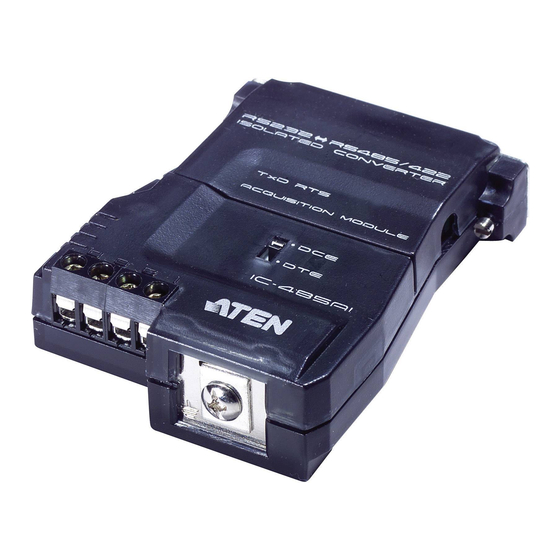Table of Contents
Advertisement
Quick Links
Download this manual
See also:
User Manual
Advertisement
Table of Contents

Subscribe to Our Youtube Channel
Summary of Contents for ATEN RS-232
-
Page 2: Fcc Information
FCC Information This equipment has been tested and found to comply with the limits for a Class B digital device, pursuant to Part 15 of the FCC Rules. These limits are designed to provide reasonable protection against harmful interference in a residential installation. This equipment generates, uses and can radiate radio frequency energy, and if not installed and used in accordance with the instruction manual, may cause interference to radio communications. -
Page 3: Telephone Support
Telephone Support International 886-2-8692-6959 China 86-10-5255-0110 Japan 81-3-5323-7178 Korea 82-2-467-6789 North America ATEN TECH 1-888-999-ATEN ATEN NJ 1-732-356-1703 United Kingdom 44-8448-158923 Technical Support For international online technical support – including troubleshooting, documentation, and software updates: http://support.aten.com For North American technical support:... -
Page 4: Package Contents
Copyright © 2006 ATEN International Co., Ltd. Manual Part No. PAPE-0075-201 Manual Date: 2010-03-26 ATEN and the ATEN logo are trademarks of ATEN International Co., Ltd. All rights reserved. All other trademarks are the property of their respective owners. - 4 -... - Page 5 Overview Although RS-232 serial ports are found on almost every computer, because of their slow transmission speeds, limited range, and limited networking capabilities, they are not an effective solution for industrial strength long distance communications systems. Systems based on the RS-485 standard, however, utilize different voltage lines for the data and control signals, so they are not subject to the RS-232 limitations.
- Page 6 The IC-485S / IC-485SI’s operating mode parameters are set with two slide switches: SW1 sets the Device Mode SW2 sets the Transmitting and Receiving Mode IC-485S Switch Settings SW 1 RS-232 DB-25 Female Connecter SW 2 Terminal Block Spare Power Jack RJ-11...
- Page 7 IC-485SI Switch Setting SW 1 RS-232 DB-25 Female Connecter SW 2 Terminal Block Power Jack Grnd. Tab Setting Position TxO, RxON TxRTS, RxRTS TxRTS, RxON - 7 -...
- Page 8 Terminology Explanations of the SW! and SW2 terms are given in the table below: Term Explanation Data Communications Equipment; if the IC-485S / IC-485SI is going to be plugged into a DTE device, the IC-485S / IC-485SI must be set to DCE.
-
Page 9: Operating Modes
Operating Modes The IC-485S / IC-485SI supports four operating modes: Point-to- Point; Multidrop; Simplex; and Monitor (IC-485S only). Point-to- Point and Multidrop can be configured for Full or Half Duplex. Each of the operating modes is explained in the sections that follow. - Page 10 2. Point-to-Point 2 Wire Half Duplex Point-to-Point Half Duplex uses straight through four wire cabling, as shown in the diagram below: DB-25 DB-25 Connect Connect to PC#1's to PC#2's COM port COM port For both IC-485S / IC-485SI units, set SW1 to DCE or DTE depending on what type of device the IC-485S / IC-485SI will plug into (if it will plug into a DCE device, configure it for DTE, and vice versa).
- Page 11 Multidrop A Multidrop configuration is one in which more than two devices are linked for communication using several IC-485S / IC-485SI units. One of the devices that one of the IC-485S / IC-485SIs connects to is designated as the Master device. All the remaining devices that the rest of the IC-485S / IC-485SIs connect to are designated as Slave devices.
- Page 12 2. Multidrop Half Duplex Multidrop Half Duplex uses straight-through four wire cabling, to link all the connected IC-485S / IC-485SI units: Slave 1 Master COM1/ COM1/ COM2 COM2 Slave 2 COM1/ COM2 Slave 3 COM1/ COM2 Slave 31 For all IC-485S / IC-485SI units, set SW1 to DCE or DTE depending on what type of device the IC-485S / IC-485SI will plug into (if it will plug into a DCE device, configure it for DTE, and vice versa).
- Page 13 Simplex A Simplex configuration is one in which more than two devices are linked for communication using several IC-485S / IC-485SI units in a manner similar to Multidrop. The difference is that in a Simplex configuration, the Master device can only talk, and the Slave devices can only listen.
- Page 14 Note: 1. The RTS must be Low in Monitor Mode. 2. The R+ and R- signals are converted and linked to the RS-232 port, DB-25 pin 3. The R’+ and R’- (T+ and T-) signals are converted and linked to the RS-232 port, DB-25 pin 2.
-
Page 15: Installation
Installation 1. Set each IC-485S / IC-485SI’s configuration switches according to the information provided in the Switch Configuration and Operating Modes sections. 2. Plug the IC-485S / IC-485SI’s DB-25 female connector into the computer’s RS-232C port. 3. Connect the IC-485S / IC-485SI units to each other: Use two or four wire twisted pair cable in a reverse or straight through configuration according to the information provided in the Switch Configuration and Operating Modes... - Page 16 Appendix The Terminal Block The four screw terminal block has different pin assignments depending on the operating mode: In DCE/DTE mode, terminals 1 (+V) and 2 (-V) are configured to transmit data (the transmitter); while terminals 3 (-V) and 4 (+V) are configured to receive data (the receiver).
- Page 17 DCE / DTE Connection Table Because of the polarity of the communication signals, a DTE configured device must connect to a DCE configured device. The shaded area in the figure below is an example of a DTE to DCE connection: Device's Connector Pin # Cable IC-485ASI...
-
Page 18: Troubleshooting
Troubleshooting Problem Action Data Transmission Check that the power adapter is plugged in Failure and working properly. Check that the IC-485S / IC-485SI units are securely plugged into the computers’ serial ports. Check that the cables are properly set up and properly connected.

















Need help?
Do you have a question about the RS-232 and is the answer not in the manual?
Questions and answers